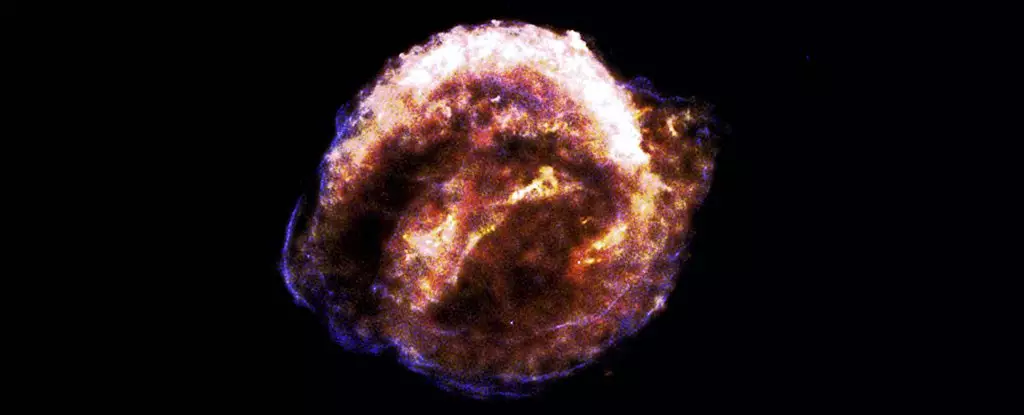

When discussing cosmic phenomena, few events are as extraordinary or influential as a supernova explosion. These colossal eruptions not only release an immense amount of energy that brightens entire galaxies, but they also play a crucial role in shaping the very fabric of our universe. Notably, supernovae are instrumental in the creation of heavy elements, such as iron, which are ejected into the void of space during these dramatic occurrences. Understanding the implications of supernovae goes beyond their dazzling visual display; it touches upon the origins of elements found within our planet, contributing to the story of life on Earth.
Recent research has shed light on the presence of the iron isotope Fe60, found in seafloor sediments dated back approximately two to six million years ago. This isotopic signature serves as a cosmic timestamp, indicating when supernova explosions occurred and how they may have influenced the environment of Earth. A paper titled “Life in the Bubble: How a nearby supernova left ephemeral footprints on the cosmic-ray spectrum and indelible imprints on life” delves into these phenomena. The lead author, Caitlyn Nojiri, emphasizes how ionizing radiation from cosmic sources consistently permeates our planet, altering the conditions under which life evolves.
An intriguing aspect of the study is the assertion that supernovae have the potential to elevate the levels of cosmic radiation that reach Earth’s surface. As our Solar System moves through the galaxy, it navigates through various regions of cosmic activity, including stellar nurseries where massive stars, known as OB stars, exist. These OB stars generate powerful solar winds that carve out “bubbles” in the interstellar medium, and our Solar System resides within one of these giant cavities, aptly named the Local Bubble. Entering this bubble created distinct conditions for Earth, possibly influencing biological evolution.
The research suggests that the younger Fe60 accumulation correlates directly with a supernova explosion that occurred around two to three million years ago in the Upper Centaurus Lupus or Tucana Horologium associations. In contrast, the older accumulation, about five to six million years old, aligns with the Solar System’s transition into the Local Bubble. Such distinctions underscore how supernovae can provide a historical record of cosmic events that might have influenced life on Earth.
While the paper outlines the potential biological effects of the radiation resulting from these supernovae, it also acknowledges the uncertainty surrounding those impacts. Initial suggestions indicate that exposure to cosmic radiation might lead to severe genetic damage, such as double-strand breaks in DNA. Such damage could result in mutations—a cornerstone of evolutionary processes—leading to greater species diversification.
The authors recognize the complexity of cosmic radiation’s impact on life. Although the radiation from supernovae may not have been potent enough to cause mass extinctions, it is conceivable that the resulting environmental conditions prompted significant evolutionary changes. Historical data, such as increased rates of virus diversification observed in Lake Tanganyika, may correlate with heightened cosmic radiation levels, but establishing a direct link requires further investigation.
Scientists speculate about the thresholds of radiation where it transitions from beneficial to harmful regarding biological effects. Due to the relatively unexplored nature of cosmic radiation—especially at ground level, where muons dominate—it remains a challenge to grasp its complete impact on biology. Consequently, understanding how cosmic radiation shapes evolutionary processes is not only vital for comprehending our past but also for predicting future biological responses.
Moreover, the concept of the universe weaving a tapestry of life on Earth invites us to ponder the delicate interplay between environmental factors and the evolution of diverse species. Cosmic events, like supernovae, may serve as hidden catalysts, precipitating changes that lead to the emergence of new life forms and the extinction of others.
The interplay between supernova explosions and life on Earth reveals the broader cosmic context in which evolution unfolds. The presence of radioactive isotopes like Fe60 in geological records signifies more than just ancient explosions; it embodies the intricate relationship between celestial phenomena and terrestrial life. As ongoing studies seek to unravel the biological effects of cosmic radiation, humanity stands at the precipice of understanding our place in the universe. Supernovae, it turns out, might not only illuminate the night sky but could also shine a light on the very origins of life itself, suggesting that cosmic happenings could have scripted a significant chapter in the tale of our existence.
A groundbreaking expedition led by an international research team, featuring esteemed scientists from the University…
The pursuit of coherent control over wave transport and localization stands as a monumental challenge…
In recent astronomical explorations, researchers have unearthed a striking phenomenon emanating from a distant corner…
The quest for sustainable practices within the chemical industry is more critical than ever. Researchers…
In the complex interplay of human health, the relationship between the gut and the brain…
The relentless drive for sustainable energy solutions has fueled remarkable advancements in solar technology, with…
This website uses cookies.